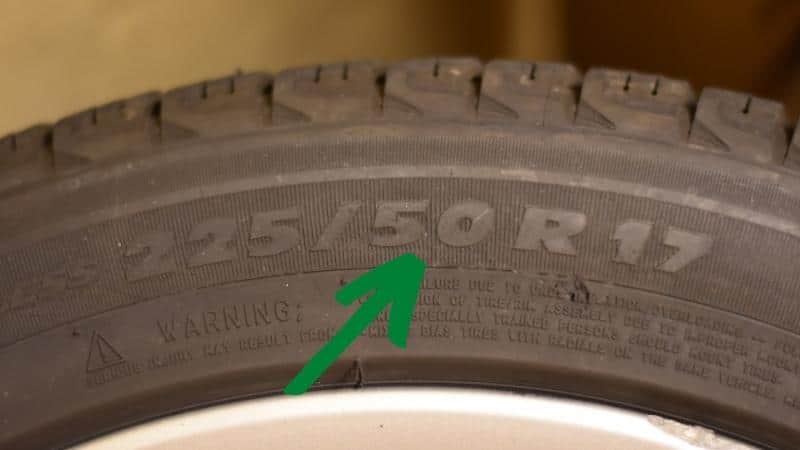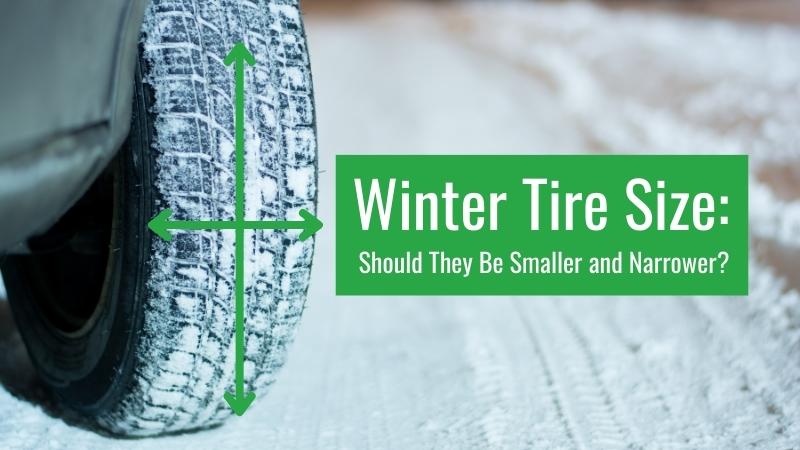As temperatures drop and winter’s icy grip takes hold, you might be considering swapping out your tires for a set better suited to snowy conditions.
However, you may be wondering whether it’s necessary to downsize your winter tires, opting for smaller and narrower ones.
This decision can have a significant impact on your vehicle’s performance and safety during the colder months.
It’s important to understand that smaller and narrower winter tires can actually offer better traction and handling in deep snow, slush, and icy conditions.
The reason for this lies in simple physics: a more focused set of contact patches allows the tire to cut through snow more effectively, thanks to the weight of your car being concentrated on a smaller area. Additionally, tires with a higher profile are less likely to aquaplane on ice or in rain, further enhancing your vehicle’s control during winter driving.
Understanding Tire Sizes

When considering winter tire sizes, it’s important to first understand the basics of tire sizing. Tires are typically sized using a series of numbers and letters on the sidewall, which indicate the dimensions and performance characteristics.
The first number you’ll find is the tire width in millimeters (mm). For example, if the tire size is “225/60R16,” the width would be 225mm. This width matters when choosing winter tires, as narrower tires can provide better traction in snow and slush by cutting through to the pavement below.
Following the width, you’ll see a two-digit number representing the aspect ratio. In our example, that would be 60. This number indicates the sidewall height and is expressed as a percentage of the tire’s width. An aspect ratio of 60 means that the sidewall height is 60% of the tire’s width.
Next is the “R” letter (in our example “225/60R16″) which stands for radial construction, meaning the layers of the tire run radially across its circumference. Finally, you’ll find the wheel diameter, also in inches. In our case, it would be a 16-inch wheel.
When selecting your winter tire size, you may want to consider downsizing the wheel diameter and width for better performance. Smaller diameters, like 16 inches, have been found to perform better in wet conditions with narrower winter tires.
Additionally, smaller wheels and tires can be less expensive. Remember to stay within 3% of the original size to maintain accurate speedometer readings and overall drivability.
Winter Tire Characteristics
Tread Patterns
When it comes to winter tires, one of the key features is the tread pattern. Winter tires have specially designed tread patterns meant to provide better traction in cold, snowy, and icy conditions. They typically feature more sipes, which are small slits in the tread that help grip the road surface.
The deeper tread depths found in these tires also help maintain traction by offering more biting edges and effectively dispersing snow and slush away from the contact patch.
Rubber Compounds
Another important characteristic of winter tires is the rubber compound used in their construction. Unlike summer tires, which are built for warmer temperatures, the rubber compounds in winter tires are formulated to stay soft and pliable in colder weather.
This flexibility allows for better grip and handling in temperatures below 50 degrees Fahrenheit (10 degrees Celsius), ensuring that you maintain control of your vehicle even in challenging winter conditions.
Stud Technology
For those who encounter severe winter conditions, studded winter tires can provide an extra level of traction. Studs are small metal or ceramic pins embedded in the tire’s tread, designed to dig into icy surfaces and provide added grip.
Some jurisdictions have restrictions on studded tire usage, so it’s essential to check your local regulations before opting for this type of winter tire. I explain more about these regulations in this post.
In summary, winter tires feature unique tread patterns, rubber compounds, and optional stud technology to provide optimal performance and safety during the colder months.
When selecting the appropriate tire size for your vehicle, consider these characteristics along with the specific weather conditions you might encounter in your area.
The Role of Tire Size in Winter Traction
When considering winter tires, it’s crucial to understand how tire size affects the overall traction and performance on snow and ice. In this section, we’ll discuss the advantages and disadvantages of narrower and wider tires.
Narrower Tires and Snow
One misconception is that smaller, narrower winter tires are better for traction on snowy roads. In reality, a narrower tire can help cut through packed snow, providing better contact between your tire and the road surface.
The smaller contact patch can improve your grip when driving on snow-covered roads, resulting in better control and performance.
For instance, a narrower tire:
- Performs better in deep snow, as it doesn’t ride on top of the snow but digs into it.
- Is less likely to hydroplane on wet or slushy surfaces, offering better wet traction.
- Provides more grip on loose or packed snow, leading to improved stability and braking.
Wider Tires and Ice
On the other hand, wider tires offer several advantages when it comes to ice or hard-packed snow. They generally provide more rubber contact with the icy surface, resulting in increased grip and stability. This can be especially beneficial on icy roads where traction is limited.
However, it is essential to understand that the increased contact patch provided by wider tires may work against you in deep or powdery snow, as they tend to ride on top instead of digging into the snow. In such conditions, you might want to consider narrower tires for better performance.
In summary, both narrower and wider tires have their pros and cons when dealing with winter driving conditions. It’s important to weigh these factors and choose the appropriate tire size based on the specific conditions you’ll encounter in your region.
Pros and Cons of Smaller and Narrower Winter Tires
Advantages
Smaller and narrower winter tires offer several benefits for driving in snowy and icy conditions. One of the main advantages is better traction. Narrower tires can more easily slice through the snow and slush, providing a longer, skinnier contact patch that improves linear traction by penetrating the snow.
Additionally, a smaller and narrower tire with a higher profile has better traction in deep snow and slush, and is much less likely to aquaplane on ice and in rain. This is due to the focused set of contact patches, resulting from the weight of the car pressing down on a smaller surface area.
Disadvantages
Despite the advantages, there are some drawbacks to using smaller and narrower winter tires. On hard-packed snow, wider tires with more sipes may perform better, providing increased grip and stability.
Furthermore, in very specific situations, such as driving on top of deep snow, wider tires might have the ability to float, which could be an advantage. However, this advantage is limited to such unique circumstances and may not be applicable to the majority of winter driving conditions.
When considering the pros and cons of smaller and narrower winter tires, it is essential to be mindful of your unique driving conditions and prioritize safety over any potential drawbacks.
Factors to Consider When Choosing Winter Tire Size
When it comes to selecting the right winter tire size, there are several factors you need to keep in mind. This section will discuss the importance of considering your vehicle type, driving conditions, and budget while choosing the appropriate winter tire size.
Vehicle Type
First, consider the type of vehicle you drive. Different vehicles have specific tire size recommendations from the manufacturer. Always check your owner’s manual or the sidewall of your current tires for the recommended tire size. Les Schwab suggests verifying the proper size before making your purchase.
Also, be aware that certain types of vehicles may require specific winter tire sizes for optimal performance. For instance, trucks or SUVs might need larger and wider tires, while sedans or hatchbacks could benefit from narrower tires.
Driving Conditions
Take into account the typical driving conditions you’ll face during the winter months. If you regularly drive on snow-covered, slushy or icy roads, you may want to consider a smaller and narrower tire.
According to Driving, narrower treads generally provide better traction on slippery surfaces. However, if you mostly drive on well-maintained roads during mild winter weather, sticking to the manufacturer-recommended tire size may be the best option for you.
Budget
Lastly, your budget plays a crucial role while selecting winter tires. Smaller and narrower winter tires can be more cost-effective than wider tires, as they require less material and are usually less expensive.
However, it’s important to strike a balance between budget and performance. You should avoid compromising on tire quality or size solely based on price. As always, prioritize safety and performance during winter driving conditions.
In conclusion, consider your vehicle type, driving conditions, and budget to make the best decision when selecting winter tire size. By keeping these factors in mind, you will be well-equipped to safely navigate the challenging winter roads.
Conclusion
When it comes to the ideal winter tire size, going smaller and narrower can be beneficial for your safety and performance on snowy and icy roads.
A narrower tire can help cut through snow and slush more effectively because the weight of your car is pressing on a more focused set of contact patches. This, in turn, offers better traction in deep snow and prevents aquaplaning on ice and rain.
Additionally, narrower winter tires can provide better traction on ice due to the increased pressure per square inch on the ground. This is a quality shared by narrow tires used by rally cars in ice and snow conditions. The improved traction of narrower winter tires can further enhance your control and safety on the road during harsh winter conditions.
In conclusion, it’s worth considering downsizing your winter tires to a smaller, narrower size with a higher profile. This will not only give you better traction on snowy and icy roads but also help in maintaining proper control of your vehicle during the winter months.
Remember to choose your winter tires wisely and always prioritize safety when driving in challenging weather conditions.
Hi, my name is Niklas, the head content creator & CEO of Whirling Wheelz. I am very interested in vehicles of all kinds, mainly cars. I have a car mechanics degree from high school and a big hobby of mine is to follow the WRC (World Rally Championship) both online and through travel.


